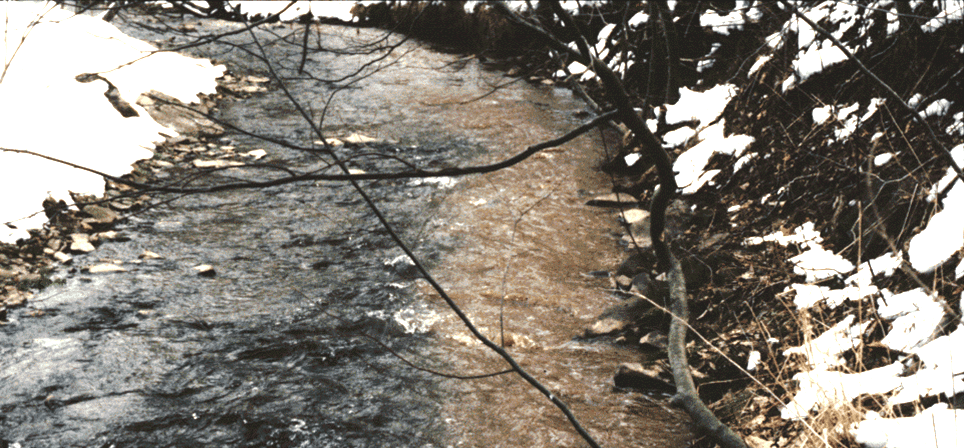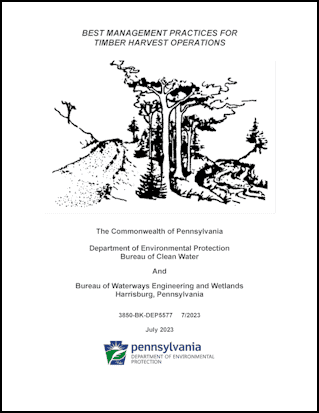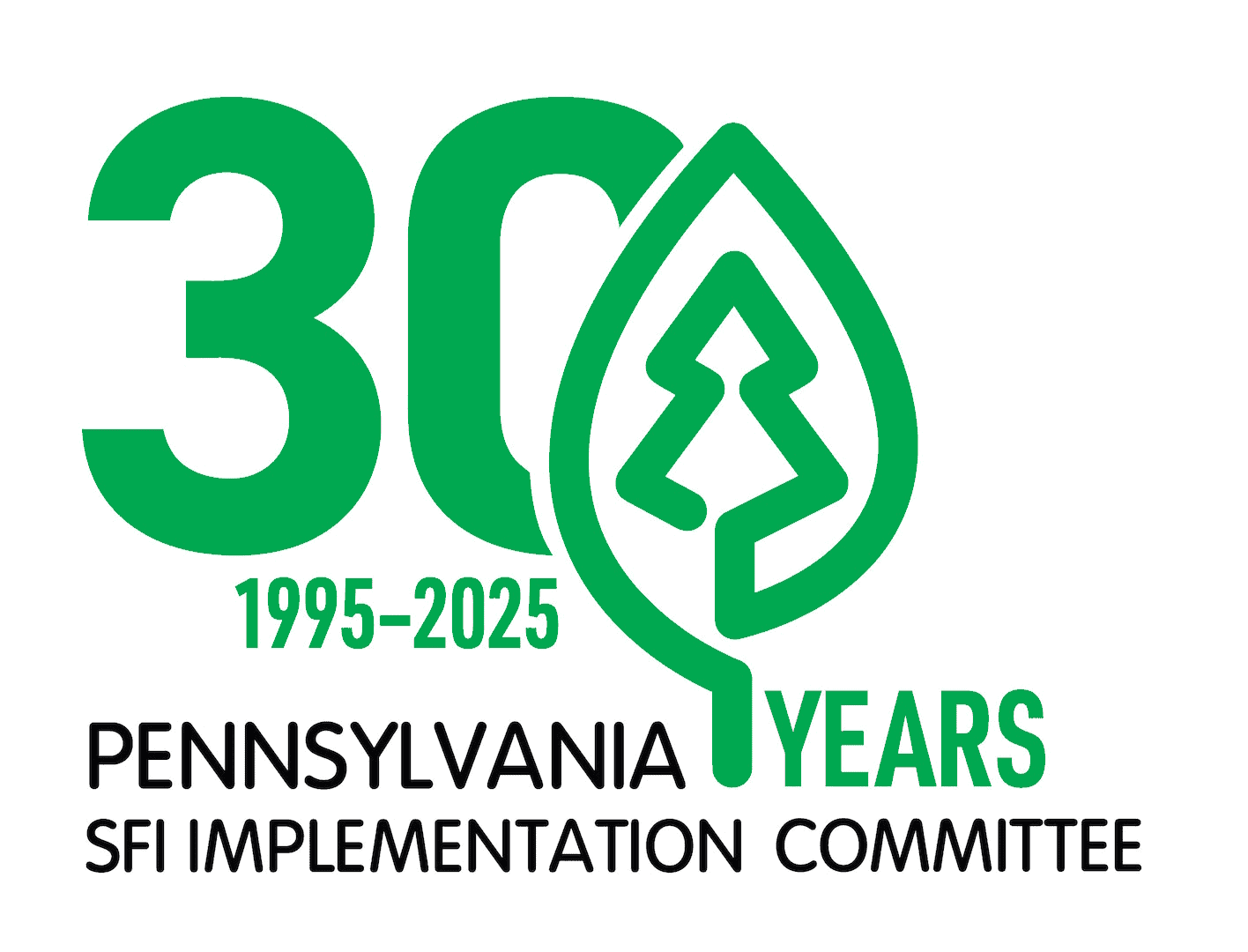
FOREST OPERATIONS >> BEST MANAGEMENT PRACTICES
An important component of Pennsylvania’s forest management guidelines is the use of forestry Best Management Practices (BMPs). BMPs are science based conservation practices that help protect soil and water resources – two key elements necessary for growing a healthy, sustainable, and productive forest. They are designed to provide an economical means of preventing or reducing sediments and other nonpoint source pollutants on managed forest lands from impacting Pennsylvania’s water resources.
[40 CFR § 130.2(m)] Best Management Practice (BMP). Methods, measures or practices selected by an agency to meet its nonpoint source control needs. BMPs include but are not limited to structural and nonstructural controls and operation and maintenance procedures. BMPs can be applied before, during and after pollution-producing activities to reduce or eliminate the introduction of pollutants into receiving waters.
[40 CFR § 122.2] Best management practices (‘‘BMPs’’) means schedules of activities, prohibitions of practices, maintenance procedures, and other management practices to prevent or reduce the pollution of ‘‘waters of the United States.’’ BMPs also include treatment requirements, operating procedures, and practices to control plant site runoff, spillage or leaks, sludge or waste disposal, or drainage from raw material storage. BMPs means ‘‘best management practices.’’
[Forest Service Handbook 2509.22] Best Management Practice (BMP). A practice or combination of practices, that is determined by a State (or designated area-wide planning agency) after problem assessment, examination of alternative practices, and appropriate public participation to be the most effective, practical (including technological, economic, and institutional considerations) means of preventing or reducing the amount of pollution generated by nonpoint sources to a level compatible with water quality goals (USFS 1988)
[25 PA Code § 102.1] BMPs – Best management practices – Activities, facilities, measures, planning or procedures used to minimize accelerated erosion and sedimentation and manage stormwater to protect, maintain, reclaim, and restore the quality of waters and the existing and designated uses of waters within this Commonwealth before, during, and after earth disturbance activities.
[Section 14] best management practices (BMPs): A practice or combination of practices for protection of water quality that is determined by a federal, provincial, state, or local government or other responsible entity, after problem assessment, examination of alternative practices, and appropriate public participation, to be the most effective and practicable (including technological, economic, and institutional considerations) means of conducting a forest management operation while addressing any environmental considerations.
Pollution that comes from broad, diffuse areas such as forest roads is referred to as nonpoint source (NPS) pollution. The name does not mean the source of the pollution is unknown, rather, that it is difficult to determine exactly where and how the pollution is getting into a waterway. Forestry BMPs are designed to control and minimize the risks of forest management activities causing NPS pollution. Sediment is the primary form of NPS pollution generated during forestry operations, however other sources could include trash, equipment fuels and lubricants, pesticides and herbicides, and organic matter (slash and other logging debris left in or against stream channels, or other water bodies).
WHY DO WE NEED FORESTRY BMPs?
Pennsylvania is home to more than one million private water wells, an estimated 86,000 miles of streams and rivers (second only to Alaska in the United States), 403,924 freshwater wetlands, and thousands of ponds, lakes and reservoirs. Timber harvesting operations and other forest management activities have the potential to create situations where various forms of pollution could be carried off into local water resources during rainfall or snow melting events. For example, dirt and gravel roads provide essential and reliable access to forests that allow for proper management; however, these roads also represent large areas of exposed sediments that can erode and wash into nearby streams, ponds, rivers, wetlands and other water bodies when poorly planned, constructed, and maintained. These sediments are harmful to aquatic resources and impair the quality of the waters. Additionally, heavy sediment loads can travel for miles resulting in far-reaching impacts to downstream users. From a landowner’s perspective, erosion robs the land of nutrient rich topsoil and its ability to grow trees. It can alter the course and flow of headwater streams.

Water quality monitoring and reporting conducted by the Pennsylvania Department of Environmental Protection (DEP) has repeatedly demonstrated the benefit and effectiveness of forestry BMPs. The most recent DEP water quality report (available under the publications section of this website) states that Less than 0.03% (three one-hundreds of a percent) of Pennsylvania’s impaired stream miles are attributed to forestry activities. This very limited impact is a direct result of Pennsylvania’s forest landowners and timber harvesters ensuring the proper use of recommended BMPs during management activities. The Pennsylvania SFI Implementation Committee has proudly educated thousands of timber harvesting administrators across the state on proper BMP use for more than 30 years.
ARE FORESTRY BMPs VOLUNTARY OR MANDATORY IN PENNSYLVANIA?
Because the waters of our Commonwealth are so critically important to all living things in Pennsylvania, implementation and maintenance of forestry BMPs is required by law (PA Code Title 25 § 102.4(b)(1)). Additionally, operations that will disturb 5,000 square feet or more of earth (~0.11 acres – which encompasses most harvesting operations) are required to develop a written Erosion and Sedimentation Control Plan (E&S Plan) that outlines the nature of the operation, the BMPs that will be used to prevent erosion and sedimentation, and a plan for how those BMPs will be maintained. Timber harvesting operations that disturb 25 or more acres (total area of haul roads, landings, and skid trails) are required to obtain an erosion and sediment control permit from DEP or their County Conservation District (Find your local Conservation District).
It is important that landowners and timber harvest administrators are familiar with Pennsylvania’s Chapter 102 Erosion and Sediment Control regulations. They should also be familiar with Chapter 105 Dam Safety and Waterway Management regulations that govern the crossing of streams (subchapter K), construction of culverts, fords and bridges (subchapter C), and other impacts to water courses and wetlands that occur during timber harvesting operations. Forest landowners should be particularly aware of their ultimate responsible for compliance with all federal, state, and local requirements.

Best Management Practices for Timber Harvest Operations (DEP publication 3850-BK-DEP5577) does an excellent job of outlining E&S BMPs and the laws related to their planning, use, maintenance, and retirement, as well as identifying permitting requirements. It provides guidance to foresters, loggers, land managers, woodland owners, and natural resource professionals in preparing and implementing soil erosion and sediment control plans, and working around forested wetlands.
County Conservation Districts – each county, except Philadelphia, has a local conservation district office that provides assistance on erosion and sedimentation pollution control. Jump to Environmental Regulations >> PA Conservation Districts.
Forest management operations are also subject to the Federal Clean Water Act (CWA) when operating in a jurisdictional wetland or crossing any “waters of the United States” including streams, sloughs, marshes, or bogs.
ADDITIONAL RESOURCES:
- DEP Regional Offices
- PA Conservation Districts
- Pennsylvania State Code
- Permit Forms
- Resources for Developing Erosion & Sedimentation Control Plan
- Other Resources
- EPA Watershed Academy – Forestry Best Management Practices in Watersheds
- Managing Your Timber – Site Layout [Video]
- Protecting Water Resources on Your Property [Webinar]
- Penn State Center for Dirt & Gravel Road Studies – Informational and Technical Bulletins
- V&V, LLC Presents: How to Build a Road [Video]
- The Importance of Forests to Water Resources [Webinar]
- Planning and Developing Access to Your Property: Forest Roads and Trails [Webinar]
- A Landowner’s Guide to Building Forest Access Roads
- Forest Stewardship: Watershed Management
- Riparian Buffers for Private Lands
- Pennsylvania Wildlife No 16: Riparian Buffers for Wildlife
- USFWS National Wetlands Inventory [Interactive Map]
- Pennsylvania Vernal Pool Identification Guide
- Pennsylvania Vernal Pool Pocket Guide
- Vernal Pools of Pennsylvania [Reporting, Mapping, Ecology, Mgmt. Guidelines, Regulations]
- Vernal Pools [Webinar]
- Jump to Environmental Regulations & Permitting

